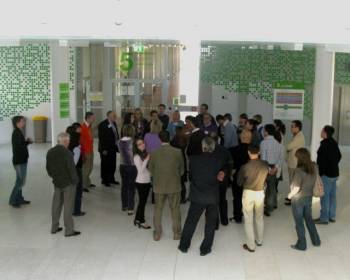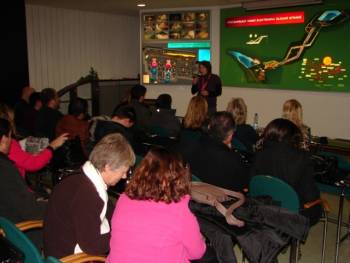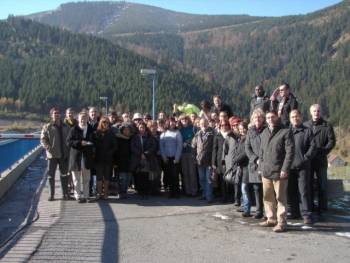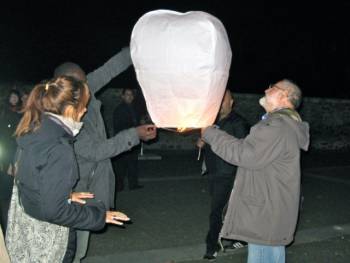Minutes of the third meeting (Olomouc, Czech Republic)
Thursday, 21/10/2010
The participants are arriving to Olomouc. The first is the UK group lead by Krzysztof, a co-organizer of the third meeting. After a long journey and an overnight stay in Prague, they take their place at a hostel near the Faculty in Science and then all the team comes to the faculty to make final preparation. The other teams which stay in a Sigma hotel gradually arrived as well – Portugal, German, Irish, Turkish, Spain and first Malta group (MECB). Some informal and welcome discussions held among partners. Early in the morning the last Maltese group from Saint Theresa came – happily, the team is complete and the workshop can start!
Friday, 22/10/2010
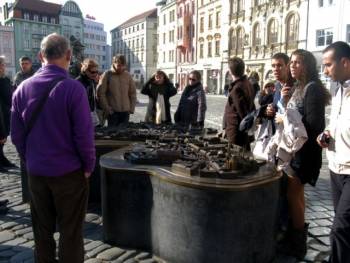 The participants from the hotel made their first experience with local trams, taking the wrong direction on their way to the faculty. Then we could open our meeting by introductory speeches and greeting by Lukáš, Krzysztof, Kevin and a vice-dean of the Faculty of Science, prof. Miloslav Dušek. Then the team was split into three groups taking parallel workshops on “Team building”, “Video analysis” and “Data logging”.
After a coffee break a first presentation section moderated by Jonathan started. It included various interesting topics:
The participants from the hotel made their first experience with local trams, taking the wrong direction on their way to the faculty. Then we could open our meeting by introductory speeches and greeting by Lukáš, Krzysztof, Kevin and a vice-dean of the Faculty of Science, prof. Miloslav Dušek. Then the team was split into three groups taking parallel workshops on “Team building”, “Video analysis” and “Data logging”.
After a coffee break a first presentation section moderated by Jonathan started. It included various interesting topics:
- Working creatively in a project – older unemployed academics work for local enterprises (Angelika Grüne,Germany)
- Adult Training on 1 : 1 Classroom Technology (Claudine Slater; Saint Theresa College, Malta)
- Search to Learn (José María Calvarro and Olga Martín; Centro de Educación de Adultos, Caceres, Spain)
- Workshop on Solar Panels (Krzysztof Bahrynowski; Joanna Pinewood Education Limited,Great Britain)
The Spanish partners prepared a small exhibition of their activities outcomes, so that each partner was given a special handmade soap. Krzysztof's seminar was supplied by an practical demonstration of solar panels (driven by the light of a lamp) and a simple bi-metal thermocouple wire immersed into a hot water. All the team also experienced the electricity flowing through the surface of the body-chain with a special toy – an (UFO ball).
The a simple lunch in a student canteen followed (with a fried fish a meal) as a introduction to a walking tour through the town centre guided by one of the most famous guides, Mr. Štefan Blaho. The excursion included the Upper square with a town hall, astronomical clock, the UNESCO recognized Holy Trinity Column and was finished in the archbishop cathedral of St. Wenceslas in the most historical part of the town.
The afternoon programme included an inspiring workshop “Creating space and time” designed by the Portuguese students Ester Simões and Tiago Norberto. The team experienced the laws governing in an early universe through playing the roles of various elementary particles.
After a coffee break an project management meeting started. Kevin as an coordinator summarized the responses of various national agencies and brought with him a printed copies of the last newsletter. Gabriel suggested the dates for the nest meeting in Romania. Jonathan turn the attention the case studies presenting examples prepared by his team and suggested an outlines for possible future project (More detailed minutes of the management meeting summarized by Kevin can be found in an internal part of this website).
An intensive discussions continued during the dinner in the Podkova (= Horseshoe) restaurant (see the served menu (946.68 KiB)).
Saturday, 23/10/2010
The main part of this day was devoted to the excursion to pumped – storage hydro power plant Dlouhé Stráně (Wikipedia link). The bus left after 8 o'clock in the morning from the hotel and an the way the UK group was picked.
The power plant represents has the greatest pumped – storage water works in the Czech Republic with the highest output reverse turbines in Europe (325MW). Also the total installed output (2x325MW) is the highest among all hydro power stations in Europe. The plant is located in a natural protected area near the villages of Loučná and Kouty nad Desnou in the Jeseniky mountains, therefore most parts are hidden under the ground, not to spoil the environment.
Enlarge the map
We passed a couple of historical towns and then went through many picturesque villages, farms and a variety of countryside. We were warned that snow had frozen and ice had formed on the higher mountain roads. Water and biscuits were distributed amongst our participants. Signatures were taken from the “captive“ audience. Large maps were shown to those who wanted to know where we were and where we were going. Suddenly we stopped in a village alongside a fast flowing river and half a dozen “Rambo” looking Czechs came on board the coach (a group of electricians which was too small for the power plant excursion, therefore they were joined with out team) Our Grundtvig participants speaking 8 different languages took this opportunity…. to invade the only tourist shop insight and use it as a pit stop. Those who needed a nicotine rush lighted up their cigarettes, discussed and waited. In time a dark haired woman in winter sports gear joined us and by her identification tag we guessed that she was indeed our guide and not the Rambo looking types. Our official guide introduced herself and pointed out various mountains and hills and within a few minutes we entered a very insecure area that looked more like a hotel resort than an information and administration centre for the ČEZ group.
Again our 44 participants disembarked and there was a mad rush for those all-important facilities; the facilities became over crowded so a couple of lads in our group made up a guard of honour and the ladies used the male facilities. The excursion started with a film presentation explaining the main fact about the power station. In the Czech Republic the ČEZ group operates 34 hydro power plants, 15 coal fuelled plants, two nuclear plants and 7 solar power plants. It also cultivates production of energy from wind power and biomass. The pump storage hydro power plant has a comfortable information auditorium with numerous photographs and plant schematics. The dark haired lady welcomed us in Czech and English and gave us much information about her “hydro plant”.
This reverse hydro pump in the Šumperk district of Moravia was started in 1978 and completed in 1989 but it was not until 1996 that the pump was running at full capacity. Two of the largest reverse Francis hydraulic turbines in Europe connect a lower reservoir of 3.4 million cubic metres on the Divoká Desná stream with an upper reservoir of 2.72 metres cubed on the Dlouhe Strane mountain. The Francis pumps are found underground in a manmade cavern approx 87.5 m by 5.5m by 50 metres. The two Francis pumps are fed by two supply lines.
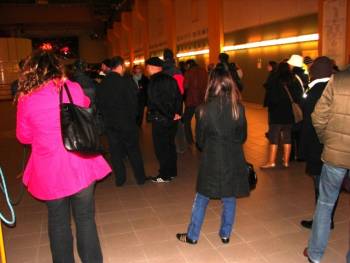 We visited this underground cave and saw just top level of the pumps. What we had under our feet was left to our imagination with the help of schematic drawing on the walls. The suspended floor was delicate and most of it was roped off. The floor was smooth and would have been ideal as a dance floor but! The access to this underground pump house was a tunnel the height of a London district/circle underground train. Along the walls were coloured circles. This art we were told was put there to prevent the isolation and anxiety of the visitors to the pump. Finally, the bus took us to the lower reservoir, where also the group photo was taken in a nice sunshine.
We visited this underground cave and saw just top level of the pumps. What we had under our feet was left to our imagination with the help of schematic drawing on the walls. The suspended floor was delicate and most of it was roped off. The floor was smooth and would have been ideal as a dance floor but! The access to this underground pump house was a tunnel the height of a London district/circle underground train. Along the walls were coloured circles. This art we were told was put there to prevent the isolation and anxiety of the visitors to the pump. Finally, the bus took us to the lower reservoir, where also the group photo was taken in a nice sunshine.
The Dlouhé stráně power plant fulfils several functions – static, dynamic and compensational. The static role of the plant is fulfilled through transformation of surplus energy in the grid into peak energy; at a time when there is a surplus of energy, mostly during the night, the water is pumped from the lower reservoir into the upper one; and in peak periods when the shortage of energy occurs, the plant is switched to a turbine mode and it produces electricity. The dynamic function of the pumped –storage power plant means that the plant functions as a backup output for the system, it can produce regulatory output and energy and therefore it adds to the administration of the grid frequency. The compensational mode of the operation serves for regulating the voltage of the system. In the information centre two films were shown about the CEZ and the hydro pump. These were videoed as well as the introduction to the group and the discussion that followed.
On the way back there was a lunch in a Handmade paper mill at Velké Losiny. As the lunch was not prepared in time, there was some space for walking around or visiting a shop with handmade paper products. During the lunch the project team sang the “Happy birthday” to Mahmut, our new Turkish friend. The bus arrived back in Olomouc before 16 o'clock, just in time for the Maltese group to catch their train to Prague.
After the return to the faculty and a coffee break, the second presentation section moderated by Mahmut Develi started. Most of the speeches and demonstrations concentrated on maths, namely:
- Workshop on numeracy (Krzysztof Bahrynowski,Great Britain) included basic numeracy revision for everyone and calculating ratios in cooking (both material were prepared as bi-lingual in both in English and Spanish);
- Teaching binary numbers (Kevin Francis Harrington, Ireland)
- Helping parents to learn again … some mathematics (Gabriel Taga and Nicolae Angelescu, Romania)
Finally, Aidan Cooper (Great Britain) presented his ideas, experiences and video on gardening. The session was closed by a short ceremony during which the participants were given their certificates of attendance.
A busy day was finished by a dinner in a historical Jesuit university complex from the 16th century – Konvikt Restaurant (see the menu (947.91 KiB)). As a farewell, the Chinese sky lanterns brought by Krzysztof were successfully launched.
Sunday, 24/10/2010
In the morning all participants left for their homes.

